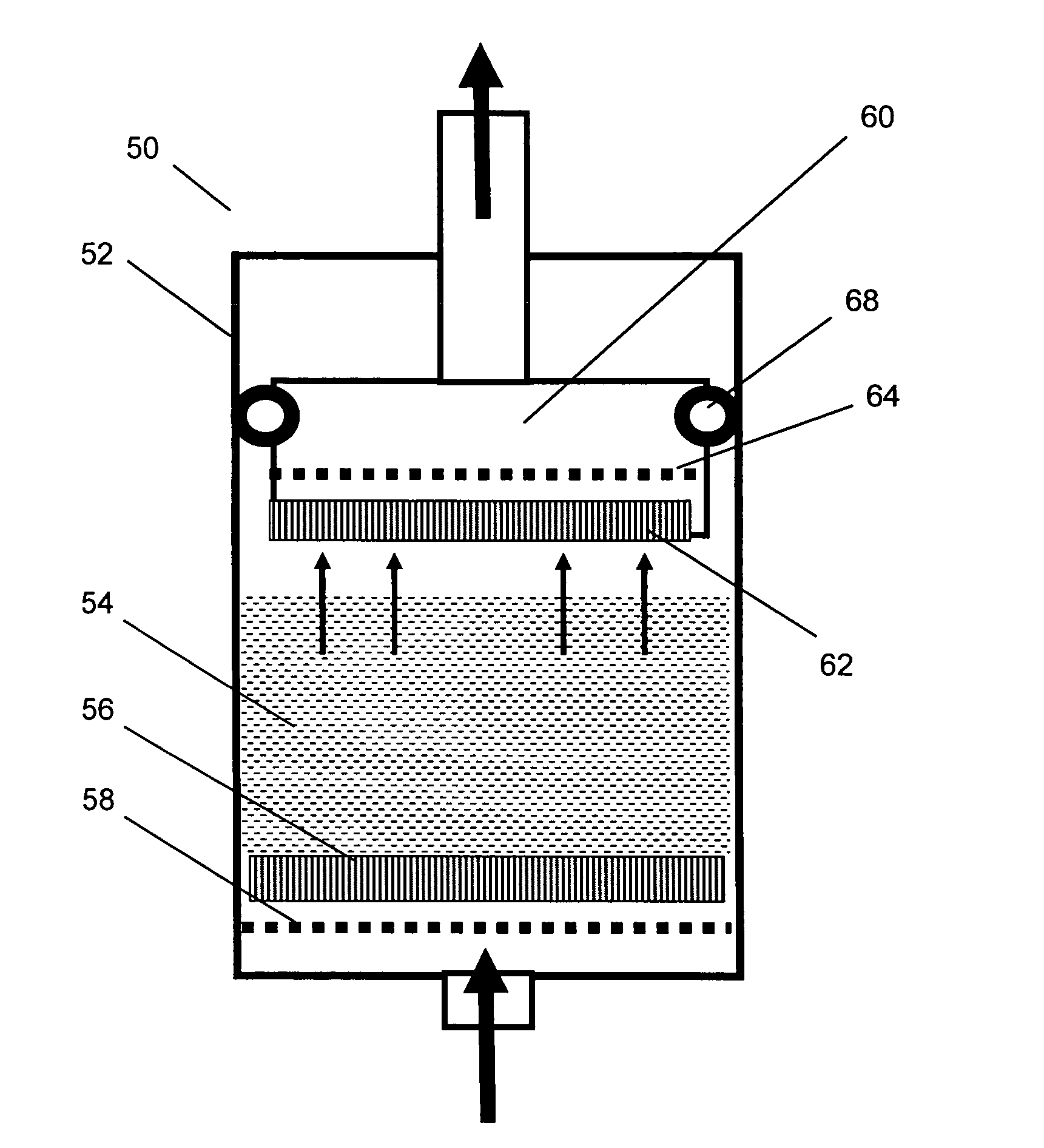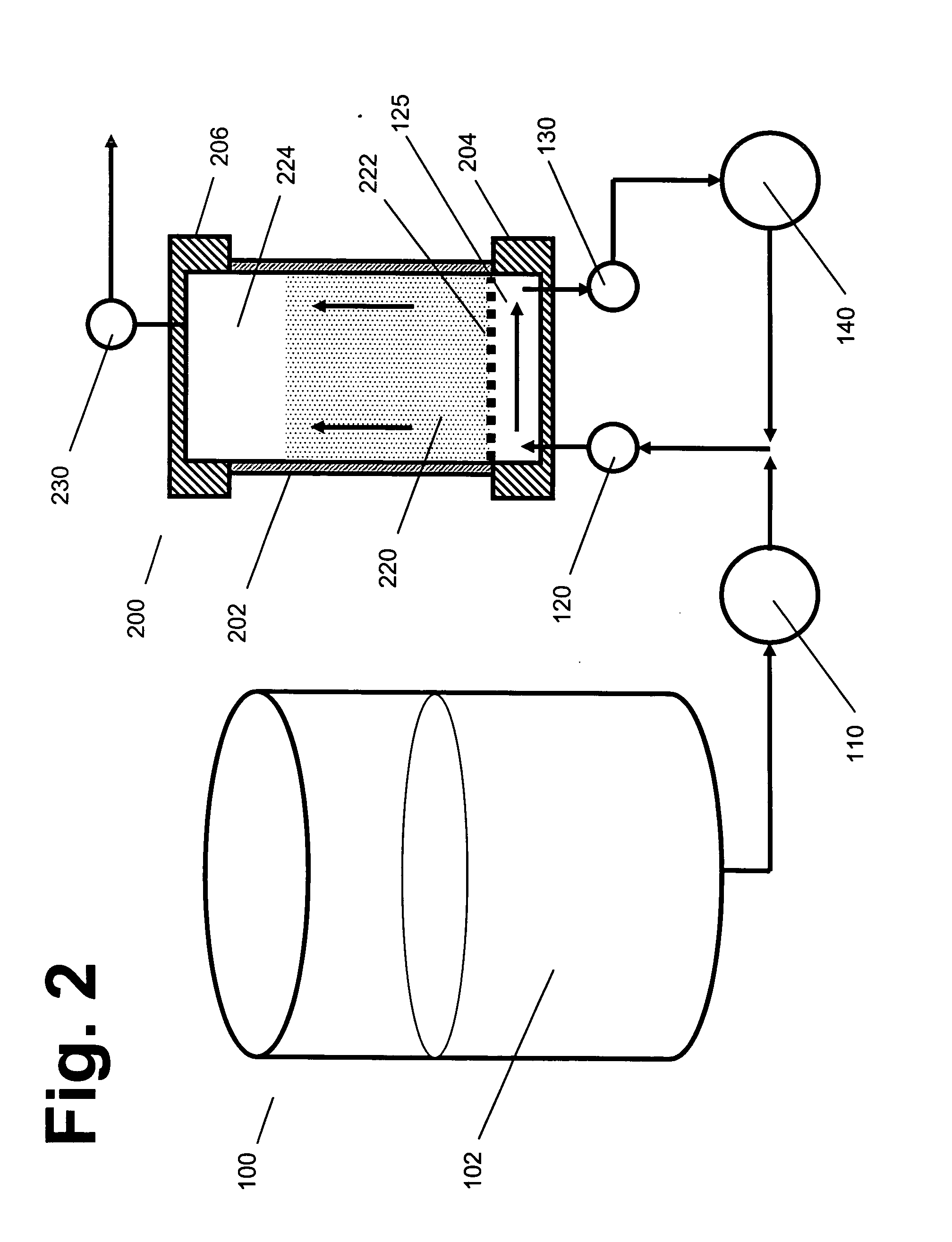One of the main problems addressed by expanded
bed chromatography is that many liquids that contain valuable target molecules also contain heavy loads of
particulates.
Such
particulates can clog up the screens that are used to hold beads, resins, or other sorbent materials in a column while liquids pass through the column; they can also cause other problems, such as forming clumps inside a column.
However, this washing step will not cause the valuable target molecules to be released by the beads.
Despite the advances that have been made in expanded bed chromatography over the past 10 years, several important problems still remain, and those problems limit or impede (and in some cases prohibit) the
processing and purification of various liquids and molecules, using true expanded bed methods and equipment.
The formation of a cake, on an inlet screen or flow-
distributor plate, will then block and impede the desired flow patterns during the rest of the
processing.
Within the channels, flow velocities are too high, and in non-channel regions, flow velocities are too low.
These uneven flow rates lead to stagnant zones, uneven
processing, and impaired purification.
This can causing even more particulates to accumulate on the screen, in a “vicious circle” type of cascading effect.
This can lead to rapid increases in back-pressure, and it often renders a column unusable from that point on, requiring the process to be
shut down so that the mesh can be cleaned.
This will cause the cake to suddenly begin releasing large quantities of
cell debris and other contaminants, into the product
pool.
This is highly adverse, and it can seriously reduce the utility of the process.
Sorbent beads that are trapped within the interior of those types of aggregates cannot participate fully in binding or
elution reactions.
If this happens, the binding capacity of the column is reduced, and purification is impaired.
In addition, it should be recognized that on a practical level,
elution and collection of valuable target molecules, using upward flow of an elution liquid, is difficult and problematic, even though it may be desirable in some cases.
Although it theoretically may be possible to carry out “plug flow” elution through a
packed bed using upward elution flow, in
actual practice, it is common for upward flow of the elution liquid to break apart the packing of the bed, causing the
packed bed to become fully or partly fluidized.
This leads to increased costs during any subsequent storage, processing, and purification.
The use of a
piston at the top of a column does nothing to prevent or reduce the formation of a particulate cake, on the bottom
distributor plate and / or inlet screen.
As a result, all of the cake-related problems mentioned above will continue to apply.
The “sliding
piston” design is somewhat complex and expensive, and is subject to a risk of jamming, breakage, or other mechanical problems (especially since “dirty” liquids are usually being processed), as compared to fixed-end column designs.
However, acrylic tubes are not well-suited for intermittent sliding of a
piston in the presence of sorbent beads (which can be very
abrasive, especially if made from minerals such as zirconia, for greater density).
Stainless steel is more capable of withstanding abrasion, but it is not transparent, so precise lowering of a piston onto a sorbent bed, at the start of an elution stage, becomes difficult, especially when it is difficult to predict the exact level where the bed will settle and compact itself to, at the end of an elution step, after the beads have become partially loaded with target molecules and with debris.
The exit screen, on the lower surface of the piston, frequently becomes somewhat clogged during the loading step.
However, without the mesh, the piston cannot be lowered directly onto the sorbent bed, since the mesh also serves as a baffle and
distributor, during elution.
Even and uniform distribution of the elution liquid, across the upper width of the column, can be seriously compromised if the exit screen is removed.
However, those approaches require additional operating delays, expenses, and other burdens, and are not entirely satisfactory.
In addition, those systems still suffer from other problems and limitations, as described above.
It should be recognized that, while expanded bed processing is quite useful for many liquids that do not contain high particulate loads (or that contain no particulate load at all), it is not practical and effective for processing other types of liquids that contain high particulate loads.
As a result, true “expanded bed” processing simply cannot be used for processing many of the types of liquids that could benefit most from such processing.
Briefly, this type of rotating distributor design uses a
fluidized bed during all stages of loading, washing, and eluting; therefore, it does not enable true “expanded bed” processing of the type that uses loading and washing of a
fluidized bed, followed by elution of a
packed bed.
However, this type of column can be operated only in an upward flow mode, and the sorbent bed remains fluidized, during elution.
The presence of internal
moving parts that must interact with
abrasive sorbent particles within the column results in a fast wear of various components, greater problems with leakage, etc.
It is difficult to disassemble the column for cleaning and
sanitation.
The requirement of
fluidized bed conditions during elution renders this
system unable to achieve the levels of concentration and purity that can be achieved by elution of packed beds.
As a result, the product is more diluted, and the diluted output requires greater
downstream processing and expenses.
This design also tends to require heavier and more
dense material for the beads, which can increase their expense and make certain types of otherwise desirable substrate materials unavailable for use in this type of column.
However, those designs suffered from other problems and performance shortcomings, and they are not being actively sold by either of the major vendors in this field.
 Login to View More
Login to View More  Login to View More
Login to View More 


